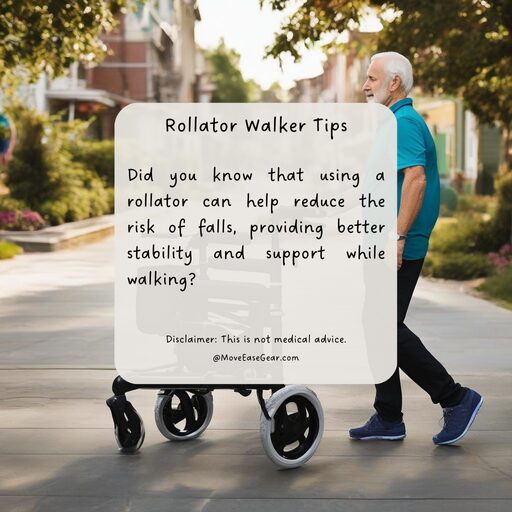*This post may contain affiliate links for which I earn commissions.*
Safety is the biggest concern one will consider when buying a rollator walker. The key features for safety can help in choosing the right rollator that provides optimum support and stability to ensure mobility and independence.
Braking System
The good braking system would provide control over speed while moving and stopping safety when using the rollator. Loop-style hand brakes are easy to use even for those users with less hand strength.
Many users with experience will find the loop brakes easy to use, and when needed, a quick stop is quite possible. Locking brakes come in handy at times when you will be using the rollator as a seat. The brakes keep the rollator in a resting position so that it cannot move an inch when resting or seated.
Wheels and Stability
The wheels contribute to both your rollator’s stability and maneuverability. Larger wheels, typically 8-10 inches in diameter, allow for easier obstacle clearance and smooth, comfortable rides on bumpy surfaces.
A wide wheelbase provides stability and thus reduces the risk of tipping over. Tires with rubber or polyurethane components provide excellent grip on any surface, indoor carpets, or outdoor pavement. Pivotal front wheels provide easy turns for added maneuverability.
Frame Design
A stable rollator requires a rigid framework to serve as its backbone. Look for high-strength, lightweight materials such as aluminum and steel that can achieve this type of strength-to-weight ratio.
Cross-bracing or X-frame designs provide added stability and are greatly valued by many users. One of the most important considerations when choosing a rollator is one with the appropriate weight capacity. Another critical aspect is models having low setups that lower the risk of tipping.
Adjustability Features
Proper fitting is critical to safe use, so adjustability features are important. Height-adjustable handles allow you to set the rollator at a comfortable level that will promote good posture and reduce strain on your back and shoulders.
If you are looking at seated models, an adjustable backrest is essential, too. Easy-to-operate adjustment mechanisms are desirable because they allow you to make adjustments easily and without outside help.

Additional Safety Elements
Many rollators include added safety features that can give you a little more confidence, such as anti-tipping wheels at the back of the device, which prevent slipping backward when moving up or down curbs or other small obstacles. Reflective tape or markings enable easy use in low-light conditions, particularly when being used outdoors.
Ergonomic hand grips are designed to reduce strain on both your hands and your wrists while grabbing onto these devices, especially with long-term use. Other designs include curb climbers to assist in crossing obstacles safely.
Seat Design (for Seated Models)
If you are going to use the seat often, then the design of this element has to be observed. A wide, padded seat provides comfort in case one prefers rest breaks; a solid backrest adds further steadiness while seated. Some of them come fitted with an additional safety belt for extra security while resting.
Conclusion
Remember that the safest rollator will be one that fits your particular needs and abilities. While these features provide an excellent starting point, make sure you consult a professional in the healthcare industry before you make your final choice.
They may help in assessing your individual requirements and be sure that you pick a rollator which is going to be of reliable support and enhance every day of living.
By knowing these key safety features, you can select a rollator that will satisfy your mobility needs and give you the required confidence to stay active and independent.
